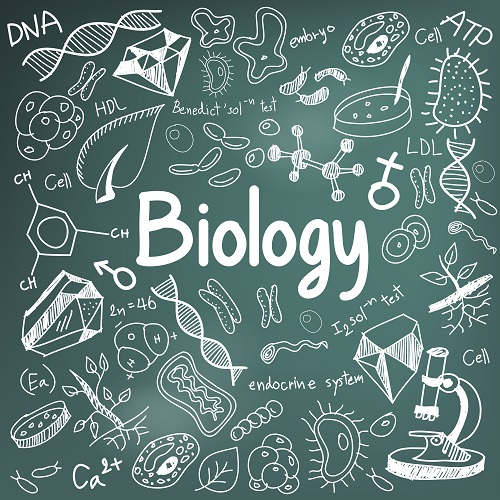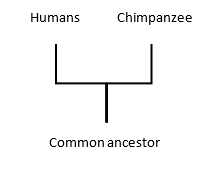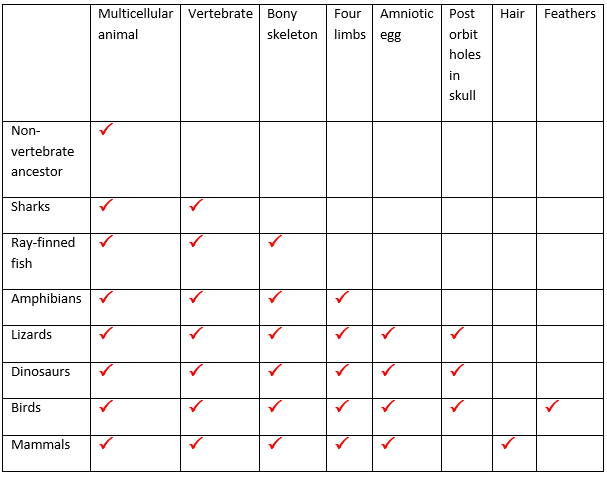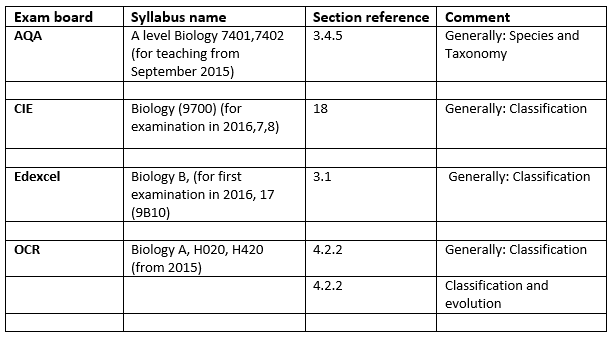Classification Blues? Try New Clades
Controversially, for a writer, I’m starting by warning you about reading. The fact is clades, or to give the study a proper title, “Cladistics” is a bit of a bore to learn about, but there is a spin-off – aside from the obvious one that it is often useful to go into an exam knowing something about what is on the syllabus – I intend that the next blog will be about South America and it’s here that we will need our newly dusted off understanding of Cladistics.
That should set the heart racing and single me out for Blogster of the Year award, but just consider: South America has not been in its present geographical position for that long and connection to North America is recent in geological terms. This means that its flora and fauna represent a time where competition with organisms from the rest of the world was paused and rather like the Galapagos Archipelago it presents a window for us to view the past and for us to understand the consequences of renewed competition once the Panama land bridge was established.
We are also an island and liable to unforeseen consequences of casual or deliberate importation of species from abroad. Studying what has happened in South America has a relevant story for us. And of course the place is, like its indigenous species, wonderfully different.
Understanding Cladistics
Cladistics is an important tool in evolutionary biology, one which attempts to build models in the form of tree diagrams to show evolutionary relationships. Cladistical analysis examines the relationships between organisms to determine the closeness of their evolutionary relationship and the direction of evolution, for example fossil record amphibians gave rise to reptiles, not the other way round. This direction is called Polarity and is sometimes not as obvious as it sounds. Consider snakes and lizards. Analysis shows that although superficially snakes seem simplified when compared to limbed lizards, the polarity direction is towards snakes; lizards are the ancestral or Plesiomorphic type.
There are 3 things we need to take for granted in Cladistics:
1.Organisms evolve over time, so changes occur. The original state is called plesiomorphic and the changed state apomorphic.
2.Organisms are related to one another by common ancestors:
This means that all life on earth is related and if we go back far enough in time, we will find the original common ancestor.
3. When change occurs, the lineage splits into two groups. There are occasions where this seems difficult to determine, for example when examining a lineage of fossils, the split may look like 3 or more organisms arose at the same time. This could be because we cannot find all of the evidence of intermediate types from the available fossil record and in reality several splits occurred, into two each time, but separated by such small time intervals to appear in the rather more indistinct fossil record as one split in several different ways. There is also, particularly in some plants, of interbreeding across species which will result in many different hybrid types occurring perhaps in just one generation.
A Cladistic method for building tree diagrams
1. First decide on the organisms or group of species that you are interested in. This could be to show evolution within a single species or more widely such as a within a genus or class. Of course, there is a term for such a group, whether a species or a higher grouping such as a genus, the term is taxon, pleural taxa.
2. Decide on the evolutionary change, we are going to use the evolution of knobs on the antennae of flies; this is of course a hypothetical example.
3. Determine which condition came first, in this case flies having antennae without knobs was ancestral (plesiomorphic) and the knobs are a more recent evolutionary change, i.e. the apomorphic state.
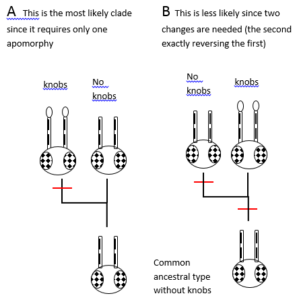
Note that although you can arrange this simple clade in two ways (A and B), arrangement A is more likely. This is yet another rule! It’s an application of an old (and very useful caution in science) called “Occam’s Razor”. Essentially this states that the simplest explanation of the observation/interpretation of the results of an experiment is most likely to be the most trustworthy. In the case of Cladistics, the same idea is conveyed by the term “Parsimony”.
This is a very simple account of cladistics methods and before we can be reasonably confident (NOT sure, remember we are taking science) that the diagram A represents an evolutionary path, we need to ask more questions.
We might consider:
• Whether other characters (other than the knobs) also change along the same lines
• Whether the interpretation fits with other observations such as increased need for sensitivity of the antenna because of a forced change of diet
• Are/were changes occurring in other taxa at the same time and if so do these observations affect confidence in the arrangement of the clade?
Here’s a construction project for you
Notes
An amniotic egg is one where a moisture retaining membrane surrounds the developing embryo.
The root of your clade is the non-vertebrate ancestor
Build your clade, answer in next blog!
Use of Cladograms
These sites give you some feel of the use of cladograms in biological research:
http://evolution.berkeley.edu/evolibrary/article/0_0_0/phylogenetics_10
http://evolution.berkeley.edu/evolibrary/article/0_0_0/phylogenetics_13
This seems a good point to sign off.
Toodle-oo,
Sphenodon.
Reading around the subject
There are a few sites which focus on the mechanism of drawing cladograms. Perhaps the most rewarding is this site which has more scope:
https://en.wikipedia.org/wiki/Evidence_of_common_descent
Particularly notice the evidence of common descent provided by cytochrome c. There are other examples here which could frame an answer for tricky parts of the A level syllabus; note the nice example of population bottleneck in relation to the small population of African humans migrating to Europe.
Some questions that you might like
1. No doubt you will have born in mind Parsimony when constructing your cladogram. Show an example of a single lack of parsimony, comment on why you think this is a less likely evolutionary construct.
Some examples of syllabus content for which the above exercise is relevant
